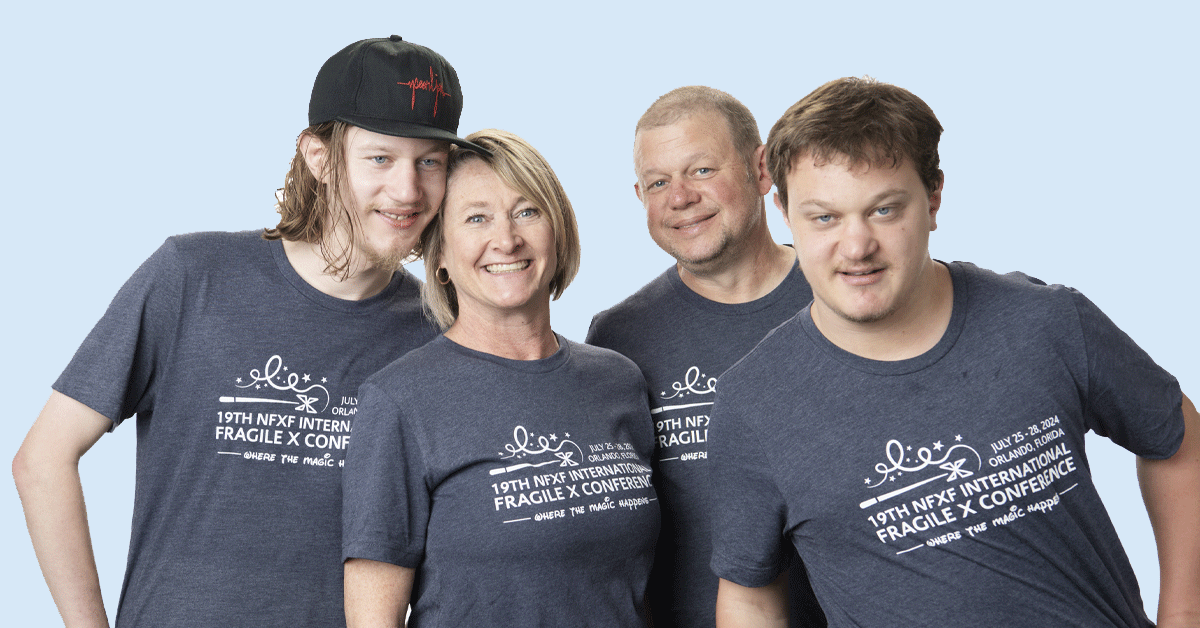Treatment and Intervention Recommendations for Fragile X

The NFXF’s family-friendly Treatment Recommendations are in-depth documents developed by NFXF staff, members of the NFXF’s Fragile X Clinical & Research Consortium (FXCRC), and other Fragile X professionals, and reviewed and edited by the entire FXCRC.
The professionals who are part of the National Fragile X Foundation’s Fragile X Clinical & Research Consortium (FXCRC) regularly review and update, as needed, the Fragile X treatment recommendations.
About the Recommendations
Professional Consensus vs. Evidence-Based Recommendations
Consensus-based recommendations develop over time, as people work with more and more children and more and more adults for a consensus to develop what works and what doesn’t. In many ways, consensus is synonymous with “professional opinion.” Coming to consensus takes time and thoughtfulness, involving much discussion and a critical review of the literature that already exists regarding the intervention.
Over time, and thanks to the early support of the FXCRC by the Centers for Disease Control (CDC), and their later support of the ongoing FORWARD Project (a longitudinal, natural history study of Fragile X syndrome), some of the newly edited documents about Fragile X syndrome will include evidence-based recommendations. These are recommendations that are based on the information collected from all the families who participate in FORWARD and other scientific research.
Using the Recommendations
The treatment and intervention recommendations are written by professionals and include input from multiple Fragile X specialists including parents and other caregivers. The documents are not formal scientific papers and, in most instances, do not include references and citations in the same way as those written for scientific journals. As needed, links are included to any relevant scientific papers as well as other, related treatment recommendations. The recommendations are published online by the NFXF to be read by parents, caregivers and other family members (and in the case of some documents, by patients), and shared with their own care professionals including doctors, therapists, educators and counselors.
Treatment Recommendations
Sleep problems can be more frequent in children with developmental disabilities, including Fragile X syndrome. Ongoing support can play an important role. Depending on the presentation and primary disorder, treatment may include behavioral, pharmaceutical, and surgical interventions.
Or open as a PDF:
All women diagnosed with primary ovarian insufficiency should undergo testing for the Fragile X premutation, even if they have no family history. Since not all women with the premutation will develop FXPOI, itʼs crucial to identify risk factors that can help predict its onset.
Multiple associated physical problems can occur with FXS, mostly related to loose connective tissue.
Or open as a PDF:
What does language development look like for individuals with FXS? We discuss receptive language (what is understood), expressive language (how an individual communicates), pragmatics (how language is used), and speech (how sounds and words are produced).
Or open as a PDF:
Taken together, the clinical assessment of individuals with FXS must be comprehensive, accommodate the unique aspects and range of the FXS phenotype, and utilize tools that are appropriate (feasible, scorable, and valid) for use in FXS and commensurate with their developmental level.
Or open as a PDF:
This article addresses mosaicism in Fragile X syndrome, though it should be noted that mosaicism is observed in many genetic conditions. In FXS, both “size” and “methylation” mosaicism are seen.
Or open as a PDF:
Based on study data, 12% of people with Fragile X syndrome have seizures, and treatment and management are similar to seizure treatment in other conditions associated with seizures. They are easily controlled in Fragile X syndrome and most patients grow out of their seizures before their 20s.
Or open as a PDF:
Assessment of individuals with FXS has numerous challenges, ranging from choice and limitations of instruments to behavioral and emotional factors in the individual that may impact the testing process to scoring and interpretation. Fortunately, decades of research and clinical experience related to assessment have provided very useful guidance.
Or open as a PDF:
There are many new issues to address as an individual with FXS becomes an adult. Services can vary widely from state to state and even vary within a state, so it is up to the parents or providers to find what is available and to set up the daily schedule for or with the person with FXS.
Or open as a PDF:
Therapy for FXTAS aims to reduce symptoms and eventually slow the progression of the disease.
Medications are, at times, helpful to facilitate the individual’s ability to attain optimal life skills and allow for better integration into educational, adult, and social environments.
Clarification on how the ASD diagnosis and FXS do and do not overlap. Understanding this distinction can be particularly helpful for genetic counseling and deciding on the most appropriate interventions.
Or open as a PDF:
Information on legal educational policies and recommendations, plus strategies and supports that have proven successful for academic and adaptive functioning.
Or open as a PDF:
For all children within the early childhood age range of birth to 5 years and especially for young children with identified disabilities associated with a diagnosis like Fragile X syndrome (FXS), inclusive, nurturing, and developmentally appropriate environments and caregiving are essential to growth and development.
Or open as a PDF:
The most common behavioral challenges seen in FXS include those associated with generalized anxiety, social interaction difficulties, ADHD, self-injury, and aggression.
By using legal guidelines such as IDEA and implementing promising vocational, educational, and life skills training practices, students with FXS can be better prepared for a successful transition into adulthood.
Or open as a PDF:
A basic framework for understanding different aspects of the educational system and an overview of the terminology. We also have resources for each level of the education system.
Or open as a PDF:
Genetic counseling includes family and medical histories to assess the chance of carriers (premutations) throughout a family’s lineage.
Or open as a PDF:
Toilet training is a characteristic area of stress for families with a child affected by FXS. Training strategies regarding when intensive toilet training techniques must be applied are based on which patients are most at risk for late toilet training.
Or open as a PDF:
Sensory-based hyperarousal is the most prevalent, troubling, and defining characteristic in Fragile X. Learning to manage hyperarousal proactively allows people to grow into themselves, not out of the problem.
Or open as a PDF:
If a family is considering complementary, alternative, or integrative therapies, we strongly recommend that they review the treatment under consideration with the physician in charge of managing the child’s FXS symptoms.
Or open as a PDF:
Teaching individuals with Fragile X syndrome personal stress-reducing strategies, such as “square breathing,” muscle relaxation techniques, and visualization of tranquil places can help them cope with unavoidable exposures to stimulation. Learn more about this plus other current treatment recommendations.
Or open as a PDF:


